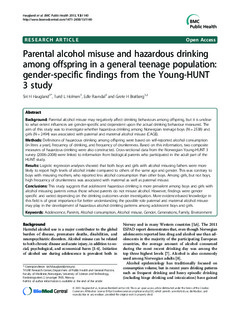| dc.contributor.author | Haugland, Siri Håvås | |
| dc.contributor.author | Holmen, Turid Lingaas | |
| dc.contributor.author | Ravndal, Edle | |
| dc.contributor.author | Bratberg, Grete | |
| dc.date.accessioned | 2015-09-11T12:35:33Z | |
| dc.date.accessioned | 2015-09-29T13:32:23Z | |
| dc.date.available | 2015-09-11T12:35:33Z | |
| dc.date.available | 2015-09-29T13:32:23Z | |
| dc.date.issued | 2013 | |
| dc.identifier.citation | BMC Public Health 2013, 13(1140) | nb_NO |
| dc.identifier.issn | 1471-2458 | |
| dc.identifier.uri | http://hdl.handle.net/11250/420986 | |
| dc.description.abstract | Background: Parental alcohol misuse may negatively affect drinking behaviours among offspring, but it is unclear
to what extent influences are gender-specific and dependent upon the actual drinking behaviour measured. The
aim of this study was to investigate whether hazardous drinking among Norwegian teenage boys (N = 2538) and
girls (N = 2494) was associated with paternal and maternal alcohol misuse (CAGE).
Methods: Definitions of hazardous drinking among offspring were based on self-reported alcohol consumption
(in litres a year), frequency of drinking, and frequency of drunkenness. Based on this information, two composite
measures of hazardous drinking were also constructed. Cross-sectional data from the Norwegian Young-HUNT 3
survey (2006–2008) were linked to information from biological parents who participated in the adult part of the
HUNT study.
Results: Logistic regression analyses showed that both boys and girls with alcohol misusing fathers were more
likely to report high levels of alcohol intake compared to others of the same age and gender. This was contrary to
boys with misusing mothers, who reported less alcohol consumption than other boys. Among girls, but not boys,
high frequency of drunkenness was associated with maternal as well as paternal misuse.
Conclusions: This study suggests that adolescent hazardous drinking is more prevalent among boys and girls with
alcohol misusing parents versus those whose parents do not misuse alcohol. However, findings were gender
specific and varied depending on the drinking outcomes under investigation. More evidence-based knowledge in
this field is of great importance for better understanding the possible role paternal and maternal alcohol misuse
may play in the development of hazardous alcohol drinking patterns among adolescent boys and girls. | nb_NO |
| dc.language.iso | eng | nb_NO |
| dc.publisher | BioMed Central | nb_NO |
| dc.title | Parental alcohol misuse and hazardous drinking among offspring in a general teenage population: gender-specific findings from the Young-HUNT 3 study | nb_NO |
| dc.type | Journal article | nb_NO |
| dc.type | Peer reviewed | en_GB |
| dc.date.updated | 2015-09-11T12:35:33Z | |
| dc.source.volume | 13 | nb_NO |
| dc.source.journal | BMC Public Health | nb_NO |
| dc.source.issue | 1140 | nb_NO |
| dc.identifier.doi | 10.1186/1471-2458-13-1140 | |
| dc.identifier.cristin | 1093848 | |
| dc.relation.project | Andre: Prosjektnummer 46027600 | nb_NO |
| dc.description.localcode | © 2013 Haugland et al.; licensee BioMed Central Ltd. This is an open access article distributed under the terms of the Creative Commons Attribution License (http://creativecommons.org/licenses/by/2.0), which permits unrestricted use, distribution, and reproduction in any medium, provided the original work is properly cited. | nb_NO |
